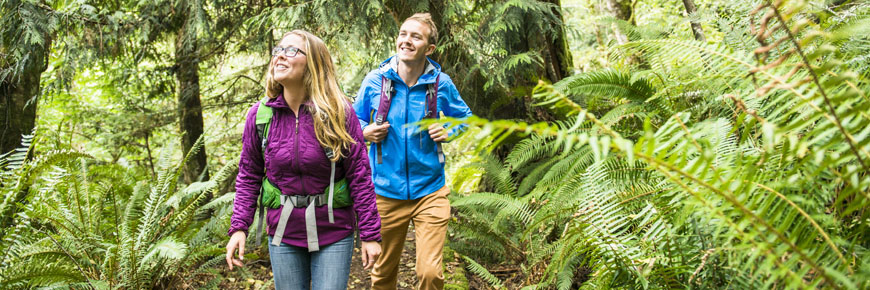
Hiking
Gulf Islands National Park Reserve
Trails
Information on frontcountry and backcountry hiking options in Gulf Islands National Park Reserve.
Visiting Gulf Islands National Park Reserve will be different than previous years. Be prepared, and know what is open and closed before you go.
Facilities and services | Pre-trip checklist | Safety tips | What you need to know
The park offers a variety of day hikes and walks for visitors of all ages and abilities, making it easy to choose a trail that is right for you.
Choose from:
- Shoreline trails to hidden coves and beaches where you can soak your feet in the Pacific
- Uphill climbs to awe-inspiring views of the Gulf Islands archipelago and surrounding waters
- Leafy forest trails where you can get closer to nature
The park is a biological hotspot. In addition to the renowned seals, sea lions and whales of the area, the park is home to eagles, herons, and a wide variety of migrating and nesting shore birds.
Facilities and services
The park maintains 13 designated trails:
- Washrooms are located at trail heads. NOTE: There are no washrooms at Lyall Creek and Roe Lake.
- Many trails start at day use areas where picnic tables are available.
- Ensure that you carry adequate water; potable water is not provided at trail heads.
- Some trails can be reached by boat only (Princess Margaret or Portland, Russell and Tumbo Islands).
- Winter Cove and Bennett Bay offer flatter, hardened or gravel trails.
- Local Parks and Recreation Commissions maintain additional trail networks on Pender, Saturna and Mayne islands.
Check out our Visitor Guide for detailed informaiton about the trails or to learn more about park facilities, including locations and operating dates.
Pre-trip checklist
When preparing for your hiking trip, ensure that you have all the hiking gear required. Here are some items you might consider packing:
- Plenty of water – Potable water is only available at car camping locations.
- Garbage bags – Garbage facilities at car campgrounds only.
- Hiking boots (non-slip are best)
- Sunscreen, sun glasses, hat and long sleeve shirt (sunscreen)
- Visitor Guide
- Hiking guide book
- Rain gear and polypropylene or fast- dry clothing
- Means of communication (cell phone)
- First aid kit
- Pocket knife
- Duct tape
- Camera
Make sure to check the Important Bulletins for closures and public safety alerts before you leave home.
Safety tips
When visiting Gulf Islands National Park Reserve, you are in an area where rescue services and medical assistance may take time to reach you in case of an emergency. Ensure that you have the level of training and experience necessary to take responsibility for your safety.
Some safety tips include:
- Hike with a partner and stay together. Tell a friend or a family member about your hiking plans.
- Wear sturdy footwear. Hiking boots with ankle support and non-slip soles are best. Rocks, especially along shorelines, can be very slippery. Be aware of rising tides when exploring shorelines and islands. Make sure that you can safely return to land.
- Carry a cell phone. NOTE: Be aware that cell phones may not work at all locations in the park due to a variety of environmental factors and your provider’s coverage area. Check with your cell plan provider regarding your coverage.
- When hiking with children, keep a close eye on them around cliffs, steep drops, and shorelines.
- If you are lost, remain calm and stay where you are. Call for help. Your chances of being found are much greater if you stay in one place. Wear bright colours.
NOTE: Traditional hunting by First Nations occurs in the park. Consider wearing bright colours, particularly in the winter. For public safety reasons, if you observe hunting in the park, please contact Parks Canada at 1-877-852-3100.
Obtain emergency contact information and learn more about Visitor Safety at Gulf Islands National Park.
What you need to know
- Stay on designated trails. The park reserve protects fragile ecosystems, trails have been designed to minimize impacts to plants and small animals such as nesting shore birds. Check out our Visitor Guide for detailed information about park designed trails.
- Trails that are not officially designated are not being maintained by the park reserve and could present safety risks and could also result in getting lost or misdirected.
- Leave all natural objects such as shells, marine creatures, plants and other treasures that you may find on the shoreline where you have found them so that others have a chance to discover them. Even shells are part of the marine ecosystem and provide shelter for other small creatures.
- When you are strolling on the rocky shore near the tide line, be careful not to crush any clams, barnacles or sea anemones. If you turn a rock over to explore the creatures that live beneath it, don’t forget to replace the rock as you found it.
- Pack out all of your garbage, this includes dog feces.
- Keep your dog on leash at all times, and please pick up after them. The presence and odor of dog feces will disturb surrounding wildlife.
Learn more about other National Park Regulations.
"Leave No Trace™" principles promote and inspire responsible outdoor recreation and stewardship. Learn more about Leave no Trace™ in Gulf Islands National Park Reserve.
- Date modified :